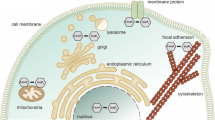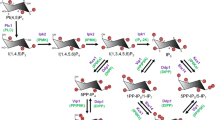Abstract
Recent advances in our understanding of the role of inositides in cell signalling have led to the central hypothesis that a receptorstimulated phosphodiesteratic hydrolysis of phosphatidylinositol 4,5-bisphosphate (PtdIns(4,5)P2)1,2 results in the formation of two second messengers, diacylglycerol3 and inositol 1,4,5-trisphosphate (Ins(l,4,5)P3)4. The existence of another pathway of inositide metabolism was first suggested by the discovery that a novel inositol trisphosphate, Ins(l,3,4)P3, is formed in stimulated tissues5; the metabolic kinetics of Ins(l,3,4)P3 are entirely different from those of Ins(l,4,5)P3 (refs 6, 7). The probable route of formation of Ins(l,3,4)P3 was recently shown to be via a 5-dephosphorylation of inositol 1,3,4,5-tetrakisphosphate (Ins(l,3,4,5)P4), a compound which is rapidly formed on muscarinic stimulation of brain slices, and which can be readily converted to Ins(l,3,4)P3 by a 5-phosphatase in red blood cell membranes8. However, the source of Ins(l,3,4,5)P4 is unclear, and an attempt to detect a possible parent lipid, phosphatidylinositol 3,4,5-trisphosphate (PtdIns(3,4,5)P3), was unsuccessful8. The recent discovery that the higher phosphorylated forms of inositol (InsP5 and InsP6) also exist in animal cells9 suggested that inositol phosphate kinases might not be confined to plant and avian tissues, and here we show that a variety of animal tissues contain an active and specific Ins(l,4,5)P3 3-kinase. We therefore suggest that an inositol tris/tetrakisphosphate pathway exists as an alternative route to the dephosphorylation10,11 of Ins(l,4,5)P3. The function of this novel pathway is unknown.
Similar content being viewed by others
References
Berridge, M. J. Biochem. J. 220, 345–360 (1984).
Downes, C. P. & Michell, R. H. in Molecular Mechanisms of Transmembrane Signalling (eds Cohen, P. & Houslay, M. D.) 3–56 (Elsevier, Amsterdam, 1985).
Nishizuka, Y. Nature 308, 693–698 (1984).
Berridge, M. J. & Irvine, R. F. Nature 312, 315–321 (1984).
Irvine, R.F., Letcher, A.J., Lander, D.J. & Downes, C.P. Biochem. J. 223, 237–243 (1984).
Irvine, R.F., Änggård, E.E., Letcher, A.J. & Downes, C.P. Biochem. J. 229, 505–511 (1985).
Burgess, G.M., McKinney, J.S., Irvine, R.F. & Putney, J.W. Biochem. J. 232, 237–243 (1985).
Batty, I. R., Nahorski, S. R. & Irvine, R. F. Biochem. J. 232, 211–215 (1985).
Heslop, J.P., Irvine, R.F., Tashjian, A.H. & Berridge, M.J. J. exp. Biol. 119, 395–402 (1985).
Downes, C. P., Mussatt, M. C. & Michell, R. H. Biochem. J. 203, 169–177 (1982).
Storey, D. J., Shears, S. B., Kirk, C. J. & Michell, R. H. Nature 312, 374–376 (1984).
Connolly, T. M., Bross, T. E. & Majerus, P. W. J. biol. Chem. 260, 7868–7874 (1985).
Irvine, R. F. & Dawson, R. M. C. J. Neurochem. 31, 1427–1434 (1978).
Connolly, T. M., Wilson, D. B., Bross, T. E. & Majerus, P. W. J. biol. Chem. 261, 122–126 (1986).
Rittenhouse, S. E. & Sasson, J. P. J. biol. Chem. 260, 8657–8660 (1985).
Mills, G. B., Cragoe, E. J., Gelfand, E. W. & Grinstein, S. J. biol. Chem. 260, 12500–12507 (1985).
Downes, C. P. & Michell, R. H. Biochem. J. 202, 53–58 (1982).
Irvine, R. F., Letcher, A. J. & Dawson, R. M. C. Biochem. J. 218, 177–185 (1984).
Wilson, D. W., Bross, T. E., Sherman, W. R., Berger, R. A. & Majerus, P. W. Proc. natn. Acad. Sci. U.S.A. 82, 4013–4017 (1985).
Dawson, R. M. C., Freinkel, N., Jungawala, F. B. & Clarke, N. Biochem. J. 122, 605–607 (1971).
Wilson, D. B. et al. J. biol. Chem. 260, 13496–13501 (1985).
Irvine, R. F., Hemington, N. & Dawson, R. M. C. Biochem. J. 164, 177–180 (1977).
Author information
Authors and Affiliations
Rights and permissions
About this article
Cite this article
Irvine, R., Letcher, A., Heslop, J. et al. The inositol tris/tetrakisphosphate pathway—demonstration of Ins(l,4,5)P3 3-kinase activity in animal tissues. Nature 320, 631–634 (1986). https://doi.org/10.1038/320631a0
Received:
Accepted:
Published:
Issue Date:
DOI: https://doi.org/10.1038/320631a0
- Springer Nature Limited
This article is cited by
-
Origin, evolution, and diversification of inositol 1,4,5-trisphosphate 3-kinases in plants and animals
BMC Genomics (2024)
-
Glutamate regulation of calcium and IP3 oscillating and pulsating dynamics in astrocytes
Journal of Biological Physics (2009)
-
Mechanistic Role of Calpains in Postischemic Neurodegeneration
Journal of Cerebral Blood Flow & Metabolism (2008)
-
Back in the water: the return of the inositol phosphates
Nature Reviews Molecular Cell Biology (2001)





